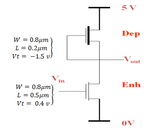mojtaba_led
Newbie level 6
hi
how can i calculate field oxide thickness of a NMOS?
I think it depends on voltage of drain so we can say :
V= Qox/Cox
Cox= (ε_0 ε_sio2 )/d
e.g. if Vd = 5 v & Qox = 1×10^11×q
thus
d= (5×8.85×10^(-14 )×3.9)/(5×10^(11 )×1.6×10^(-19 ) ))=2.16*10^(-5 )= .216 μm
what's your idea?
is it right ?
how can i calculate field oxide thickness of a NMOS?
I think it depends on voltage of drain so we can say :
V= Qox/Cox
Cox= (ε_0 ε_sio2 )/d
e.g. if Vd = 5 v & Qox = 1×10^11×q
thus
d= (5×8.85×10^(-14 )×3.9)/(5×10^(11 )×1.6×10^(-19 ) ))=2.16*10^(-5 )= .216 μm
what's your idea?
is it right ?
